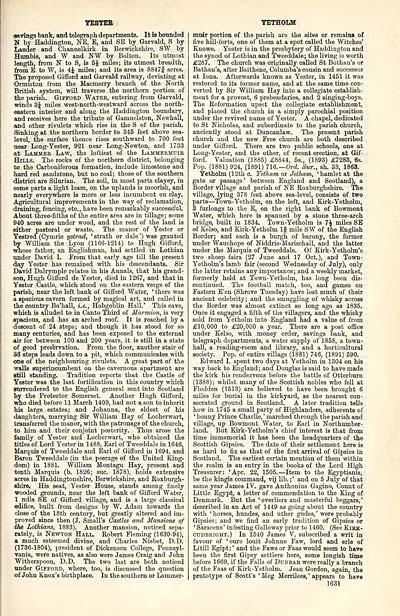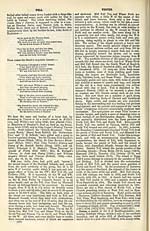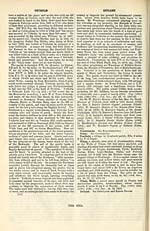Ordnance gazetteer of Scotland
(1639) Page 1631 - YES
Download files
Complete book:
Individual page:
Thumbnail gallery: Grid view | List view

TESTER
«avings bank, and telegraph departments. It is bounded
N by Haddington, NE, E, and SE by Garvald, S by
Lauder and Channelkirk in Berwickshire, SW by
Humbie, and W and NW by Bolton. Its utmost
length, from N to S, is 5 J miles; its utmost breadth,
from E to W, is 4 J miles; and its area is 8847§ acres.
The proposed Gifford and Garvald railway, deviating at
Ormiston from the Macmerry branch of the North
British system, will traverse the northern portion of
the parish. Gifford Water, entering from Garvald,
winds 3£ miles west-north-westward across the north-
eastern interior and along the Haddington boundary,
and receives here the tribute of Gamuelston, Newhall,
and other rivulets which rise in the S of the parish.
Sinking at the northern border to 346 feet above sea-
level, the surface thence rises southward to 700 feet
near Long-Yester, 921 near Long-Newton, and 1733
at Lammer Law, the loftiest of the Lammermt/ir
Hills. The rocks of the northern district, belonging
to the Carboniferous formation, include limestone and
hard red sandstone, but no coal; those of the southern
district are Silurian. The soil, in most parts clayey, in
some parts a light loam, on the uplands is moorish, and
nearly everywhere is more or less incumbent on clay.
Agricultural improvements in the way of reclamation,
draining, fencing, etc., have been remarkably successful.
About three-fifths of the entire area are in tillage; some
940 acres are under wood, and the rest of the land is
either pastoral or waste. The manor of Yester or
Yestred (Cymric ystrad, ' strath or dale ') was granted
by William the Lyon (1166-1214) to Hugh Gifford,
whose father, an Englishman, had settled in Lothian
under David I. From that ear!y age till the present
day Yester has remained with his descendants. Sir
David Dalrymple relates in his Annals, that his grand-
son, Hugh Gifford de Yester, died in 1267, and that in
Yester Castle, which stood on the eastern verge of the
parish, near the left bank of Gifford Water, ' there was
a spacious cavern formed by magical art, and called in
the country Bo'hall, i.e., Hobgoblin Hall.' This cave,
which is alluded to in Canto Third of Marmion, is very
spacious, and has an arched roof. It is reached by a
descent of 24 steps; and though it has stood for so
many centuries, and has been exposed to the external
air for between 100 and 200 years, it is still in a state
of good preservation. From the floor, another stair of
36 steps leads down to a pit, which communicates with
■one of the neighbouring rivulets. A great part of the
walls superincumbent on the cavernous apartment are
still standing. Tradition reports that the Castle of
Yester was the last fortification in this country which
surrendered to the English general sent into Scotland
by the Protector Somerset. Another Hugh Gifford,
who died before 11 March 1409, had not a son to inherit
his large estates; and Johanna, the eldest of his
daughters, marrying Sir William Hay of Locherwart,
transferred the manor, with the patronage of the church,
to him and their conjoint posterity. Thus arose the
family of Yester and Locherwart, who obtained the
titles of Lord Yester in 1488, Earl of Tweeddale in 1646,
Marquis of Tweeddale and Earl of Gifford in 1694, and
Baron Tweeddale (in the peerage of the United King-
dom) in 1881. William Montagu Hay, present and
Tfcenth Marquis (b. 1826; sue. 1878), holds extensive
acres in Haddingtonshire, Berwickshire, and Roxburgh-
shire. His seat, Yester House, stands among finely
wooded grounds, near the left bank of Gifford Water,
1 mile SE of Gifford village, and is a large classical
edifice, built from designs by W. Adam towards the
close of the 18th century, but greatly altered and im-
proved since then (J. Small's Castles and Mansions of
the Lothians, 1883). Another mansion, noticed sepa-
rately, is Newton Hall. Robert Fleming (1630-94),
a much esteemed divine, and Charles Nisbet, D.D.
(1736-1804), president of Dickenson College, Pennsyl-
vania, were natives, as also were James Craig and John
Witherspoon, D.D. The two last are both noticed
under Gifford, where, too, is discussed the question
•of John Knox's birthplace. In the southern or Lammer-
YETHOLM
muir portion of the parish are the sites or remains of
five hill-forts, one of them at a spot called the Witches'
Knowe. Yester is in the presbytery of Haddington and
the synod of Lothian and Tweeddale; the living is worth
£287. The church was originally called St Bothan's or
Bathan's, after Baithene, Columba's cousin and successor
at Iona. Afterwards known as Yester, in 1451 it was
restored to its former name, and at the same time con-
verted by Sir William Hay into a collegiate establish-
ment for a provost, 6 prebendaries, and 2 singing-boys.
The Reformation upset the collegiate establishment,
and placed the church in a simply parochial position
under the revived name of Yester. A chapel, dedicated
to St Nicholas, and subordinate to the parish church,
anciently stood at Duncanlaw. The present parish
church and the new Free church are both described
under Gifford. There are two public schools, one at
Long-Yester, and the other, of recent erection, at Gif-
ford. Valuation (1885) £8844, 5s., (1893) £7283, 6s.
Pop. (1881) 924, (1891) 716.— Ord. Sur., sh. 33, 1863.
Yetholm (12th o. Yetham or Jetharn, ' hamlet at the
gate or passage' between England and Scotland), a
Border village and parish of NE Roxburghshire. The
village, lying 378 feet above sea-level, consists of two
parts — Town-Yetholm, on the left, and Kirk- Yetholm,
3 furlongs to the E, on the right bank of Bowmont
Water, which here is spanned by a stone three-arch
bridge, built in 1834. Town-Yetholm is 7£ miles SE
of Kelso, and Kirk- Yetholm If mile SW of the English
Border; and each is a burgh of barony, the former
under Wauchope of Niddrie-Marischall, and the latter
under the Marquis of Tweeddale. Of Kirk-Yetholm's
two sheep fairs (27 June and 17 Oct.), and Town-
Yetholm's lamb fair (second Wednesday of July), only
the latter retains any importance; and a weekly market,
formerly held at Town-Yetholm, has long been dis-
continued. The football match, too, and games on
Fastern E'en (Shrove Tuesday) have lost much of their
ancient celebrity; and the smuggling of whisky across
the Border was almost extinct so long ago as 1835.
Once it engaged a fifth of the villagers, and the whisky
sold from Yetholm into England had a value of from
£10,000 to £20,000 a year. There are a post office
under Kelso, with money order, savings bank, and
telegraph departments, a water supply of 1858, a town-
hall, a reading-room and library, and a horticultural
society. Pop. of entire village (1881) 746, (1891) 590.
Edward I. spent two days at Yetholm in 1304 on his
way back to England ; and Douglas is said to have made
the kirk his rendezvous before the battle of Otterburn
(1388); whilst many of the Scottish nobles who fell at
Flodden (1513) are believed to have been brought 6
miles for burial in the kirkyard, as the nearest con-
secrated ground in Scotland. A later tradition tells
how in 1745 a small party of Highlanders, adherents of
' bonny Prince Charlie, ' marched through the parish and
village, up Bowmont Water, to Earl in Northumber-
land. But Kirk-Yetholm's chief interest is that from
time immemorial it has been the headquarters of the
Scottish Gipsies. The date of their settlement here is
as hard to fix as that of the first arrival of Gipsies in
Scotland. The earliest certain mention of them within
the realm is an entry in the books of the Lord High
Treasurer: 'Apr. 22, 1505. — Item to the Egyptianis,
be the kingis command, vij lib. ;' and on 5 July of that
same year James IV. gave Anthonius Gagino, Count of
Little Egypt, a letter of commendation to the King of
Denmark. But the 'overliers and masterful beggars,'
described in an Act of 1449 as going about the country
with ' horses, hundes, and uther gudes, ' were probably
Gipsies; and we find an early tradition of Gipsies or
' Saracens' infesting Galloway prior to 1460. (See Kirk-
cudbright.) In 1540 James V. subscribed a writ in
favour of 'ouro louit Johnne Faw, lord and erle of
Litill Egipt; ' and the Faws or Faas would seem to have
been the first Gipsy settlers here, some longish time
before 1669, if the Falls of Dunbar were really a branch
of the Faas of Kirk-Yetholm. Jean Gordon, again, the
prototype of Scott's ' Meg Merrilees, ' appears to have
1631
«avings bank, and telegraph departments. It is bounded
N by Haddington, NE, E, and SE by Garvald, S by
Lauder and Channelkirk in Berwickshire, SW by
Humbie, and W and NW by Bolton. Its utmost
length, from N to S, is 5 J miles; its utmost breadth,
from E to W, is 4 J miles; and its area is 8847§ acres.
The proposed Gifford and Garvald railway, deviating at
Ormiston from the Macmerry branch of the North
British system, will traverse the northern portion of
the parish. Gifford Water, entering from Garvald,
winds 3£ miles west-north-westward across the north-
eastern interior and along the Haddington boundary,
and receives here the tribute of Gamuelston, Newhall,
and other rivulets which rise in the S of the parish.
Sinking at the northern border to 346 feet above sea-
level, the surface thence rises southward to 700 feet
near Long-Yester, 921 near Long-Newton, and 1733
at Lammer Law, the loftiest of the Lammermt/ir
Hills. The rocks of the northern district, belonging
to the Carboniferous formation, include limestone and
hard red sandstone, but no coal; those of the southern
district are Silurian. The soil, in most parts clayey, in
some parts a light loam, on the uplands is moorish, and
nearly everywhere is more or less incumbent on clay.
Agricultural improvements in the way of reclamation,
draining, fencing, etc., have been remarkably successful.
About three-fifths of the entire area are in tillage; some
940 acres are under wood, and the rest of the land is
either pastoral or waste. The manor of Yester or
Yestred (Cymric ystrad, ' strath or dale ') was granted
by William the Lyon (1166-1214) to Hugh Gifford,
whose father, an Englishman, had settled in Lothian
under David I. From that ear!y age till the present
day Yester has remained with his descendants. Sir
David Dalrymple relates in his Annals, that his grand-
son, Hugh Gifford de Yester, died in 1267, and that in
Yester Castle, which stood on the eastern verge of the
parish, near the left bank of Gifford Water, ' there was
a spacious cavern formed by magical art, and called in
the country Bo'hall, i.e., Hobgoblin Hall.' This cave,
which is alluded to in Canto Third of Marmion, is very
spacious, and has an arched roof. It is reached by a
descent of 24 steps; and though it has stood for so
many centuries, and has been exposed to the external
air for between 100 and 200 years, it is still in a state
of good preservation. From the floor, another stair of
36 steps leads down to a pit, which communicates with
■one of the neighbouring rivulets. A great part of the
walls superincumbent on the cavernous apartment are
still standing. Tradition reports that the Castle of
Yester was the last fortification in this country which
surrendered to the English general sent into Scotland
by the Protector Somerset. Another Hugh Gifford,
who died before 11 March 1409, had not a son to inherit
his large estates; and Johanna, the eldest of his
daughters, marrying Sir William Hay of Locherwart,
transferred the manor, with the patronage of the church,
to him and their conjoint posterity. Thus arose the
family of Yester and Locherwart, who obtained the
titles of Lord Yester in 1488, Earl of Tweeddale in 1646,
Marquis of Tweeddale and Earl of Gifford in 1694, and
Baron Tweeddale (in the peerage of the United King-
dom) in 1881. William Montagu Hay, present and
Tfcenth Marquis (b. 1826; sue. 1878), holds extensive
acres in Haddingtonshire, Berwickshire, and Roxburgh-
shire. His seat, Yester House, stands among finely
wooded grounds, near the left bank of Gifford Water,
1 mile SE of Gifford village, and is a large classical
edifice, built from designs by W. Adam towards the
close of the 18th century, but greatly altered and im-
proved since then (J. Small's Castles and Mansions of
the Lothians, 1883). Another mansion, noticed sepa-
rately, is Newton Hall. Robert Fleming (1630-94),
a much esteemed divine, and Charles Nisbet, D.D.
(1736-1804), president of Dickenson College, Pennsyl-
vania, were natives, as also were James Craig and John
Witherspoon, D.D. The two last are both noticed
under Gifford, where, too, is discussed the question
•of John Knox's birthplace. In the southern or Lammer-
YETHOLM
muir portion of the parish are the sites or remains of
five hill-forts, one of them at a spot called the Witches'
Knowe. Yester is in the presbytery of Haddington and
the synod of Lothian and Tweeddale; the living is worth
£287. The church was originally called St Bothan's or
Bathan's, after Baithene, Columba's cousin and successor
at Iona. Afterwards known as Yester, in 1451 it was
restored to its former name, and at the same time con-
verted by Sir William Hay into a collegiate establish-
ment for a provost, 6 prebendaries, and 2 singing-boys.
The Reformation upset the collegiate establishment,
and placed the church in a simply parochial position
under the revived name of Yester. A chapel, dedicated
to St Nicholas, and subordinate to the parish church,
anciently stood at Duncanlaw. The present parish
church and the new Free church are both described
under Gifford. There are two public schools, one at
Long-Yester, and the other, of recent erection, at Gif-
ford. Valuation (1885) £8844, 5s., (1893) £7283, 6s.
Pop. (1881) 924, (1891) 716.— Ord. Sur., sh. 33, 1863.
Yetholm (12th o. Yetham or Jetharn, ' hamlet at the
gate or passage' between England and Scotland), a
Border village and parish of NE Roxburghshire. The
village, lying 378 feet above sea-level, consists of two
parts — Town-Yetholm, on the left, and Kirk- Yetholm,
3 furlongs to the E, on the right bank of Bowmont
Water, which here is spanned by a stone three-arch
bridge, built in 1834. Town-Yetholm is 7£ miles SE
of Kelso, and Kirk- Yetholm If mile SW of the English
Border; and each is a burgh of barony, the former
under Wauchope of Niddrie-Marischall, and the latter
under the Marquis of Tweeddale. Of Kirk-Yetholm's
two sheep fairs (27 June and 17 Oct.), and Town-
Yetholm's lamb fair (second Wednesday of July), only
the latter retains any importance; and a weekly market,
formerly held at Town-Yetholm, has long been dis-
continued. The football match, too, and games on
Fastern E'en (Shrove Tuesday) have lost much of their
ancient celebrity; and the smuggling of whisky across
the Border was almost extinct so long ago as 1835.
Once it engaged a fifth of the villagers, and the whisky
sold from Yetholm into England had a value of from
£10,000 to £20,000 a year. There are a post office
under Kelso, with money order, savings bank, and
telegraph departments, a water supply of 1858, a town-
hall, a reading-room and library, and a horticultural
society. Pop. of entire village (1881) 746, (1891) 590.
Edward I. spent two days at Yetholm in 1304 on his
way back to England ; and Douglas is said to have made
the kirk his rendezvous before the battle of Otterburn
(1388); whilst many of the Scottish nobles who fell at
Flodden (1513) are believed to have been brought 6
miles for burial in the kirkyard, as the nearest con-
secrated ground in Scotland. A later tradition tells
how in 1745 a small party of Highlanders, adherents of
' bonny Prince Charlie, ' marched through the parish and
village, up Bowmont Water, to Earl in Northumber-
land. But Kirk-Yetholm's chief interest is that from
time immemorial it has been the headquarters of the
Scottish Gipsies. The date of their settlement here is
as hard to fix as that of the first arrival of Gipsies in
Scotland. The earliest certain mention of them within
the realm is an entry in the books of the Lord High
Treasurer: 'Apr. 22, 1505. — Item to the Egyptianis,
be the kingis command, vij lib. ;' and on 5 July of that
same year James IV. gave Anthonius Gagino, Count of
Little Egypt, a letter of commendation to the King of
Denmark. But the 'overliers and masterful beggars,'
described in an Act of 1449 as going about the country
with ' horses, hundes, and uther gudes, ' were probably
Gipsies; and we find an early tradition of Gipsies or
' Saracens' infesting Galloway prior to 1460. (See Kirk-
cudbright.) In 1540 James V. subscribed a writ in
favour of 'ouro louit Johnne Faw, lord and erle of
Litill Egipt; ' and the Faws or Faas would seem to have
been the first Gipsy settlers here, some longish time
before 1669, if the Falls of Dunbar were really a branch
of the Faas of Kirk-Yetholm. Jean Gordon, again, the
prototype of Scott's ' Meg Merrilees, ' appears to have
1631
Set display mode to: Large image | Transcription
Images and transcriptions on this page, including medium image downloads, may be used under the Creative Commons Attribution 4.0 International Licence unless otherwise stated. ![]()
| Gazetteers of Scotland, 1803-1901 > Ordnance gazetteer of Scotland > (1639) Page 1631 - YES |
|---|
| Permanent URL | https://digital.nls.uk/97412914 |
|---|

